|
|
|
Sort Order |
|
|
|
Items / Page
|
|
|
|
|
|
|
| Srl | Item |
| 1 |
ID:
059723
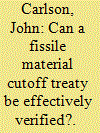

|
|
|
|
|
| Publication |
Jan-Feb 2005.
|
|
|
|
|
|
|
|
|
|
|
|
|
|
|
|
| 2 |
ID:
127633
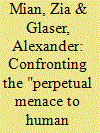

|
|
|
|
|
| Publication |
2014.
|
| Summary/Abstract |
Nuclear weapon states historically have attached great secrecy to their nuclear weapon and fissile material production programs and stockpiles, despite warnings that this would fuel fears, handicap informed debate and decision making, and drive arms races. As evidenced by the "Action Plan on Nuclear Disarmament" agreed upon at the 2010 Treaty on the Non-Proliferation of Nuclear Weapons (NPT) Review Conference, however, the international community now sees greater transparency about nuclear weapon and fissile material stocks as necessary for enabling and monitoring progress toward nuclear disarmament. To support this effort, the International Panel on Fissile Materials has proposed a step-by-step program for weapon states to declare their inventories, production histories, and disposition of nuclear warheads and fissile materials, and to set up joint projects to develop methods for verifying these declarations. This openness initiative is described here, and could be adopted at the 2015 NPT Review Conference, laying a basis for negotiating verifiable deep reductions in nuclear arsenals and their eventual elimination.
|
|
|
|
|
|
|
|
|
|
|
|
|
|
|
|
| 3 |
ID:
096502
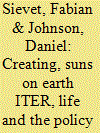

|
|
|
|
|
| Publication |
2010.
|
| Summary/Abstract |
Concerns about climate change and energy security have prompted some countries to revive dormant nuclear fission power programs to meet growing energy demands and reduce carbon dioxide emissions. However, this so-called nuclear renaissance based on fission would have major drawbacks in the areas of safety, security, and nonproliferation. Nuclear fusion, however, is portrayed by its proponents as mitigating these drawbacks, and scientists continue to pursue fusion's promise with two large-scale projects: the International Thermonuclear Experimental Reactor (ITER), and the Laser Inertial Fusion Engine (LIFE) reactor. Although supporters often hail fusion as proliferation resistant, the technology could be used to create weapons-usable fissile material. This article explains how fissile material could be created in ITER or LIFE and analyzes other nonproliferation implications of fusion; the authors discuss the various challenges faced by ITER and LIFE.
|
|
|
|
|
|
|
|
|
|
|
|
|
|
|
|
| 4 |
ID:
072884
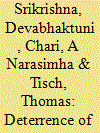

|
|
|
|
|
| Publication |
2005.
|
| Summary/Abstract |
The United States has multiple nuclear detection initiatives to secure against a terrorist nuclear attack, including the Container Security Initiative, installation of radiation detectors at U.S. border points of entry, and establishment of the Domestic Nuclear Detection Office (DNDO). The current nuclear detection system architecture falls short of being able to reliably catch fissile nuclear material in transit, specifically shielded Highly Enriched Uranium (HEU) and Plutonium (Pu), both within the US and abroad. Checkpoints at border crossings can be circumvented, and no adequate system is under development to deter the transport of fissile materials. Using nuclear link-budget calculations, we show why a network relying primarily on handhelds, fixed detectors, and portals is not sufficient. We examine the technical, economic, and operational feasibility of a comprehensive national network incorporating in-vehicle detectors to reliably detect and deter the transport of fissile material inside the vehicle itself.
|
|
|
|
|
|
|
|
|
|
|
|
|
|
|
|
| 5 |
ID:
111133
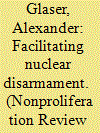

|
|
|
|
|
| Publication |
2012.
|
| Summary/Abstract |
Unprecedented interest in seeking progress toward nuclear disarmament exists today; even some nuclear weapon states are looking for new ways to strengthen this process. National declarations of fissile material holdings-highly enriched uranium and plutonium-could play an important role in supporting this effort, facilitating not only transparency but also the irreversibility of the process. This article discusses what kind of content such declarations could have in order to be meaningful and effective, the sequence of data on fissile material holdings that states might release, and some of the challenges to be expected in reconstructing historic fissile material production; it also summarizes current attitudes of weapon states toward making such declarations. Initial declarations can be valuable as confidence-building measures, but better and more background data are necessary if declarations are to serve as the groundwork for deeper cuts in the nuclear arsenals. A robust verification approach would ultimately require inspectors to have access to fissile material production and storage sites. The methods and tools of nuclear forensic analysis-in this context also dubbed nuclear archaeology-would be a key element of this process. This article discusses the capabilities and limitations of potential approaches to verifying declarations of historic production of plutonium and highly enriched uranium; it also identifies and discusses opportunities for further research and development.
|
|
|
|
|
|
|
|
|
|
|
|
|
|
|
|
| 6 |
ID:
012151
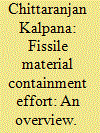

|
|
|
|
|
| Publication |
July 1997.
|
| Description |
623-633
|
|
|
|
|
|
|
|
|
|
|
|
|
|
|
|
| 7 |
ID:
099030
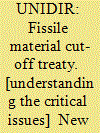

|
|
|
|
|
| Publication |
New York, United Nations, 2010.
|
| Description |
xiv, 129p.
|
| Series |
UNIDIR/2010/4
|
|
|
|
|
|
|
|
|
|
|
|
Copies: C:1/I:0,R:0,Q:0
Circulation
| Accession# | Call# | Current Location | Status | Policy | Location |
| 055254 | 355.825119/UNI 055254 | Main | On Shelf | General | |
|
|
|
|
| 8 |
ID:
018798
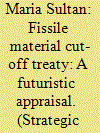

|
|
|
|
|
| Publication |
Spring 2001.
|
| Description |
65-103
|
|
|
|
|
|
|
|
|
|
|
|
|
|
|
|
| 9 |
ID:
109458
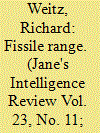

|
|
|
| 10 |
ID:
086468


|
|
|
|
|
| Publication |
2009.
|
| Summary/Abstract |
The Obama administration has stated its intention to conclude a treaty cutting off production of fissile material, highly enriched uranium (HEU) and plutonium, for nuclear weapons. So did the administrations of George W. Bush and Bill Clinton. Although a fissile material cutoff treaty (FMCT) has been a key objective of the UN Conference on Disarmament (CD) for many years, that organization seems unable to break out of its now customary paralysis.[1] This experience should encourage the Obama administration, if indeed it wants such a treaty, to look to another forum for realization. More importantly, it may be vital for the new U.S. administration to take a different approach because pursuit of an FMCT as currently contemplated at the CD might well have the ironic and presumably unintended consequence of gravely undermining the nuclear nonproliferation regime. Fortunately, such a new approach may well be available.
|
|
|
|
|
|
|
|
|
|
|
|
|
|
|
|
| 11 |
ID:
114438
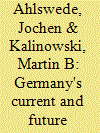

|
|
|
|
|
| Publication |
2012.
|
| Summary/Abstract |
In the past, Germany reprocessed a significant amount of its spent nuclear fuel, partly on its own territory but mostly as a customer of British and French reprocessing plants. In mid-2005, Germany stopped this practice, banning new transports of spent fuel for reprocessing-although the already-exported material would be allowed to be reprocessed and recycled in German reactors as mixed-oxide (MOX) fuel. In total, about 6,500 tonnes of heavy metal have been contracted for reprocessing, but a significant portion of this material has neither been reprocessed nor recycled as MOX fuel in German reactors. Due to the complex import-export history and the partly nontransparent information policy of the German government and utilities, a comprehensive and up-to-date plutonium balance for Germany is not publicly available. This report provides an assessment of Germany's plutonium inventory (stored domestically or abroad) based on open-source information. Special attention is paid to the issue of whether the entire inventory of separated plutonium can be completely irradiated in German nuclear reactors before the last of them are shut down in 2022. The authors conclude that Germany's stock of plutonium waiting to be recycled was about 12.2 tonnes as of 2010; this plutonium should be completely re-imported from the United Kingdom and France by 2017. Germany's MOX-consumption capacities should be sufficient to irradiate the remaining plutonium, although further delays are expected that could leave Germany with an inventory of separated (unirradiated) plutonium.
|
|
|
|
|
|
|
|
|
|
|
|
|
|
|
|
| 12 |
ID:
156583
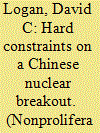

|
|
|
|
|
| Summary/Abstract |
Arguments about China's nuclear-modernization program and its implications for US nuclear policy rest on a fundamental misunderstanding. American experts have resurrected fears of a Chinese nuclear “breakout”—defined here as either development of a nuclear-warfighting capability or a significant and rapid increase in the scale of China's nuclear arsenal—to justify significant changes to US nuclear policies. In addition to the “soft” political constraints on China's nuclear arsenal, Beijing also faces a number of “hard” technical constraints, especially on a “sprint to parity” with the United States and Russia. A Chinese nuclear breakout would require significant changes to China's nuclear infrastructure that are likely to be highly detectable. The United States, while being vigilant for indications of a future Chinese nuclear breakout, should also adopt policies that decrease the likelihood of such changes.
|
|
|
|
|
|
|
|
|
|
|
|
|
|
|
|
| 13 |
ID:
167796
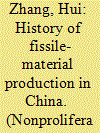

|
|
|
|
|
| Summary/Abstract |
This article reconstructs the history of China’s production of highly enriched uranium and plutonium for nuclear weapons based on newly available public sources. It begins with discussion of China’s first set of fissile-material production facilities, which China started building in 1958. It then details the first and second “third-line” construction campaigns, initiated in 1964 and the late 1960s, respectively. Finally, the article considers the policy implications of the history of China’s fissile-material production, particularly its influence on China’s attitude toward negotiating a fissile-material cutoff treaty.
|
|
|
|
|
|
|
|
|
|
|
|
|
|
|
|
| 14 |
ID:
022646


|
|
|
|
|
| Publication |
Summer 2002.
|
| Description |
112-120
|
|
|
|
|
|
|
|
|
|
|
|
|
|
|
|
| 15 |
ID:
101653
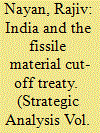

|
|
|
|
|
| Publication |
2011.
|
| Summary/Abstract |
The international community inside and outside the Conference of Disarmament is underscoring the need for concluding a fissile material cut-off treaty (FMCT). The Indian government, for a long period, has been sponsoring the idea. Notwithstanding the international stagnation, the issue has been instigating periodic debate in India on the Indian approach. The periodic revival of the issue requires that India revisit its policy on fissile material production as well as its approach towards a possible FMCT. This article examines the question: should India's approach to conclude an FMCT be within the UN institutional framework? The new international reality is pushing for a new context, new realignments and a fresh outlook for an FMCT. India should take its own time to support conclusion of an FMCT so that its national interests and security are not adversely affected.
|
|
|
|
|
|
|
|
|
|
|
|
|
|
|
|
| 16 |
ID:
105626


|
|
|
| 17 |
ID:
126372
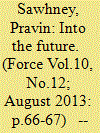

|
|
|
|
|
| Publication |
2012.
|
| Summary/Abstract |
The new Defence Research and Development Organisation (DRDO) chief Avinash Chander has recently said that phase-I of the indigenous ballistic missile defence (BMD) programme is over and the missile shield is ready for the protection of New Delhi, the capital of India. Phase I is for interception of 2,000km range enemy missiles, and phase II for killing 5,000km range missiles. This implies that the BMD technology demonstrator phase is over and the DRDO would ask for additional massive funds to deploy the actual weapon system. This spectacular news has reached China and Pakistan; Chinese scholars are comparing it with their own indigenous BMD programme and Pakistan would use this to further justify increased production of more ballistic and cruise missiles, and fissile material.
|
|
|
|
|
|
|
|
|
|
|
|
|
|
|
|
| 18 |
ID:
079943
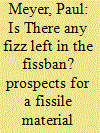

|
|
|
| 19 |
ID:
135250


|
|
|
|
|
| Summary/Abstract |
The Fissile Material (Cutoff) Treaty (fm(c)t) has been on the negotiation agenda since 1996, but has seen little progress. This is due to a fundamental disagreement over whether emphasis should be placed on nuclear disarmament or nuclear non-proliferation. Several delegations perceive the fm(c)t as a tool to draw in states from outside the non-proliferation regime, while others understand it to be a disarmament measure that reduces quantities of fissile materials for nuclear weapons. They however, regard the unwillingness of nuclear weapon states to engage toward this end as deeply unjust. Additional disagreements also concern justice: Should there be different standards of verification? May some states continue to produce unverified military fuel? As long as the nuclear weapon states only push their interests through pure power instead of respecting the notion of justice, no progress can be expected and the non-proliferation regime will further erode.
|
|
|
|
|
|
|
|
|
|
|
|
|
|
|
|
| 20 |
ID:
129119
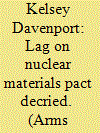

|
|
|
|
|
| Publication |
2014.
|
| Summary/Abstract |
The failure of several key states to ratify a nuclear security treaty ahead of this month's nuclear security summit is a disappointment, but an Indonesian initiative may increase the pace of ratifications, an official familiar with the preparations for the meeting said. The two previous nuclear security summits, in Washington in 2010 and Seoul in 2012, have emphasized the importance of the entry into force of a 2005 amendment to the Convention on the Physical Protection of Nuclear Material (CPPNM). The March 24-25 summit in The Hague is also likely to encourage ratification of this treaty. The original treaty, which entered into force in 1987, sets security standards for nuclear material in transit. Its 2005 amendment would expand the scope of the physical protection measures to cover material in storage. An additional 26 ratifications are necessary to reach the 98 necessary for bringing the amendment into force. Although the 2012 Seoul summit communiqué urged states "in a position to do so to accelerate their domestic approval" of the amendment in order to achieve entry into force by 2014, 17 of the 53 summit participants have yet to ratify it
|
|
|
|
|
|
|
|
|
|
|
|
|
|
|
|
|
|
|
|
|